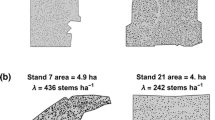Summary
Two alternative estimators of individual tree leaf area (A1) area are used to derive estimates of leaf-area index (L) for 40 plots in Pinus contorta Dougl. stands. One estimator of A1 is based on the common assumption of a constant ratio between A1 and sapwood cross-sectional area at breast height (As). The second estimator of A1 accounts for tree-to-tree variation in the relation between A1 and As. The apparent relationship between stand growth and leaf-area index is strongly dependent on the way leaf area is estimated. When L is derived from a constant A1∶As ratio, stand growth appears to be strongly correlated with L. However, when L is based on estmates of A1 that account for tree-to-tree variation in the A1 — As relation, stand growth is seen to be only weakly related to L. Stand structure, quantified as percent live-crown, accounts for a great deal of the observed variation in leaf-area efficiency. These contrasting relationships illustrate the importance of unbiased estimates of L in interpreting the link between stand-level processes and leaf area.
Similar content being viewed by others
References
Albrektson A (1984) Sapwood basal area and needle mass of Scot's pine (Pinus sylvestris L.) trees in Central Sweden. Forestry 57: 35–43
Assmann E (1970) The principles of forest yield study. Pergamon Press, Oxford
Caldwell MM, Dean TJ, Nowak RS, Dzurec RS, Richards JH (1983) Bunchgrass architecture, light interception, and water-use efficiency: assessment by fiber optic point quadrants and gas exchange. Oecologia 59: 178–184
Dean TJ, Long JN (1985) Response of self-thinning to artifically reduced levels of leaf area in monocultures of Trifolium pratense. Ann Bot 55: 361–366
Dean TJ, Long JN (1986) Variation in sapwood area-leaf area relations within two stands of lodgepole pine. For Sci 32: 749–758
Espinosa Bancalari MA, Perry DA, Marshall JD (1987) Leaf area-sapwood area relationships in adjacent young Douglas fir stands with different early growth rates. Can J For Res 17: 174–180
Grier CC, Waring RH (1974) Conifer foliage mass related to sapwood area. For Sci 20: 205–206
Kaufmann MR, Troendle CA (1981) The relationship of leaf area and foliage biomass to sapwood conducting area in four subalpine forest tree species. For Sci 27: 477–482
Keane MG, Weetman GF (1987) Leaf area-sapwood cross-sectional area relationships in repressed stands of lodgepole pine. Can J For Res 17: 205–209
Kittredge J (1944) Estimation of the amount of foliage of trees and stands. J For 42: 905–912
Lang ARG, Yueqin X (1986) Estimation of leaf area index from transmission of direct sunlight in discontinuous canopies. Agric For Meteor 37: 229–243
Long JN (1985) A practical approach to density management. For Chron 61: 23–27
Long JN, Dean TJ (1986) Sapwood area of Pinus contorta stands as a function of mean size and density. Oecologia 68:410–412
Long JN, Smith FW (1984) Relation between size and density in developing stands: a description and possible mechanism. For Ecol Manage 7: 191–206
Lonsdale WM, Watkinson AR (1982) Light and self-thinning. New Pytol 90: 431–445
Maguire DA, Hann DW (1987) Equations for predicting sapwood area at crown base in southwestern Oregon Douglas-fir. Can J For Res 17: 236–241
Marshall JD, Waring RH (1986) Comparison of methods of estimating leaf-area index in old-growth Douglas-fir. Ecology 67: 975–979
Moller C (1947) The effect of thinning, age, and site on foliage, increment, and loss of dry matter. J For 45: 393–404
Monsi M, Uchijima Z, Oikawa T (1973) Structure of foliage canopies and photosynthesis. Annu Rev Ecol Syst 4: 301–327
Oren R, Week KS, Schulze ED (1986) Relationships between foliage and conducting xylem in Picea abies (L.) Karst. Trees 1: 61–69
Panshin AJ, DeZeeuw C (1970) Textbook of wood technology, vol 1. McGraw-Hill, New York
Pearson JA, Fahey TJ, Knight DH (1984) Biomass and leaf area in contrasting lodgepole pine forests. Can J For Res 14: 259–265
Schimpf DJ, Henderson JA, MacMahon J (1980) Some aspects of succession in the spruce-fir forest zone of Northern Utah. Great Basin Nat 40: 1–26
Waring RH (1983) Estimating forest growth and efficiency in relation to canopy leaf area. Adv Ecol Res 13: 327–354
Waring RH, Schlesinger WH (1985) Forest ecosystems: concepts and management. Academic Press, Orlando
Waring RH (1985b) Imbalanced forest ecosystems: assessments and consequences. For Ecol Manage 12: 93–112
Waring RH, Newman K, Bell J (1981) Efficiency of tree crowns and stemwood production at different canopy leaf densities. Forestry 54: 129–137
Whitehead D (1978) The estimation of foliage area from sapwood basal area in Scot's pine. Forestry 51: 137–149
Whitehead D, Edwards WRN, Jarvis PG (1984) Conducting sapwood area, foliage area, and permeability in mature trees of Picea sitchensis and Pinus contorta. Can J For Res 14: 940–947
Author information
Authors and Affiliations
Additional information
Utah Aggriculural Experiment Station Journal Paper No. 3333
Rights and permissions
About this article
Cite this article
Dean, T.J., Long, J.N. & Smith, F.W. Bias in leaf area — sapwood area ratios and its impact on growth analysis in Pinus contorta . Trees 2, 104–109 (1988). https://doi.org/10.1007/BF00196756
Received:
Issue Date:
DOI: https://doi.org/10.1007/BF00196756




